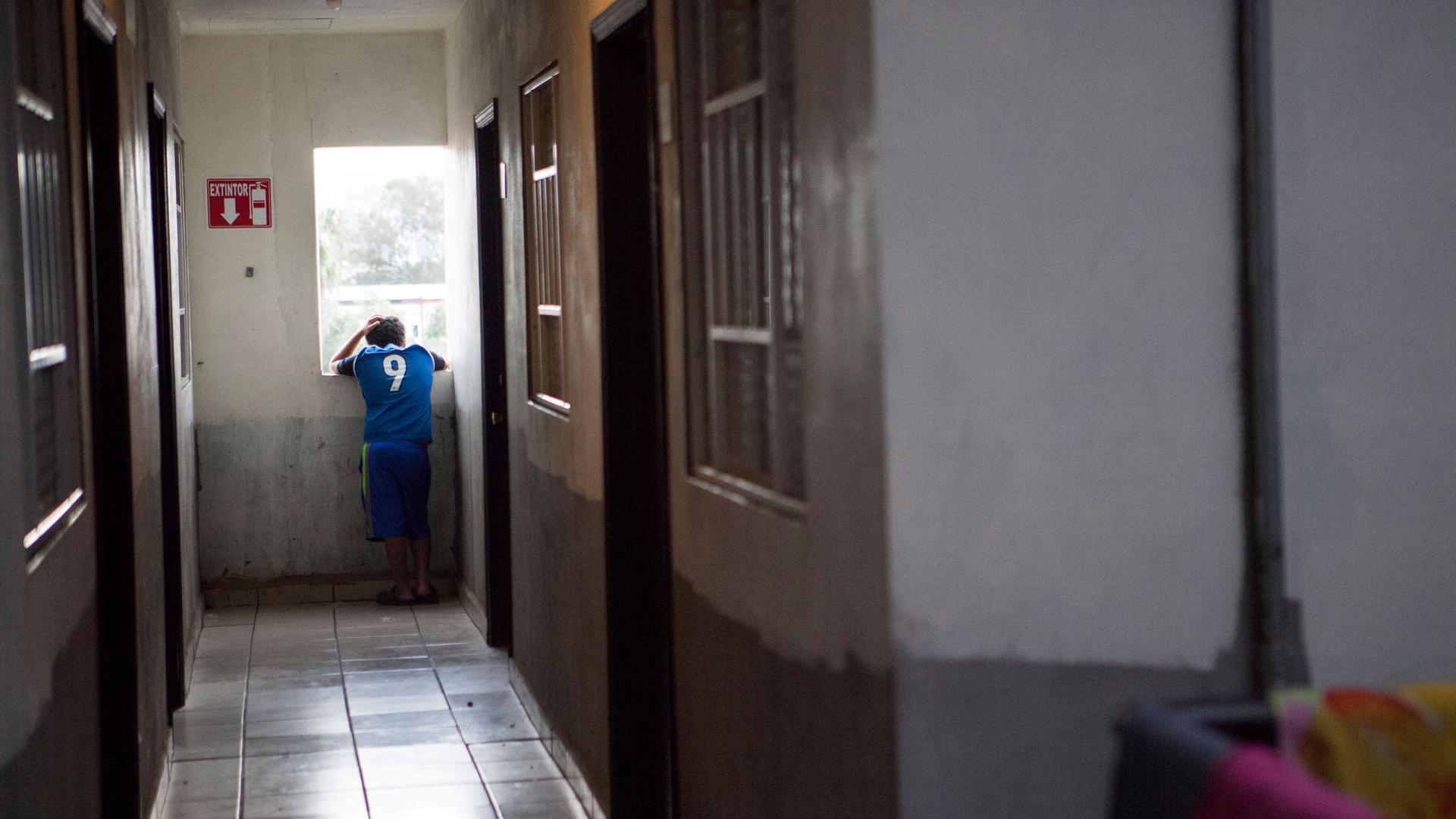Thousands of people are on the informal, numbered waitlist. It moves slowly, some days not at all. US government officials say that they have limited capacity to process the number of migrants at the border.
The slow pace has created a massive bottleneck, transforming some parts of Mexico’s northern border into a so-called “waiting room” for thousands of migrants.
Related: US and Mexico need to ‘work against a discourse of hate and racism,’ ambassador says
While most people at the border arrive from Central America, namely Guatemala, Honduras and El Salvador, others come from continents away. In our first story, we hear from Rawand Rahman, a Kurdish Iraqi now sharing a room in Tijuana, Mexico, with other migrants from Yemen. Rahman made his way to South America and then trekked north through the notorious Darién Gap, a roadless stretch of rainforest that runs through Colombia and Panama. Valery, a Cameroonian, took the same journey. We hear from him in the third installment of our series. He is now on day 72 in Tijuana and waits for an opportunity to make his case for asylum at the US border.
Related: Trump administration moves to stop more immigrants from seeking US asylum
However, many other migrants at the border have traveled far shorter distances. That is the case of Juventina and her family who fled their home in the central-Mexican state of Michoacán because of cartel-related threats. They became internally displaced asylum-seekers waiting to enter into the US from the very country they are fleeing. She and her family are featured in our second story.
In our final story, we hear about one of the Trump administration’s bolder initiatives at the border. The policy’s official name is Migrant Protection Protocols (MPP), but it is also known as “remain in Mexico.” Implemented in late January, MPP requires some asylum-seekers who approach US officials at the US-Mexico border to be returned to Mexico to wait as their case moves through a US court.
Related: Trump’s hard-line immigration policies build on the history of former US presidents
While waiting in Mexico, often for months between hearings, asylum-seekers must find a way to get by. In the final story in our series, we meet Jeff Mendoza, a young man in the MPP program who is fleeing violence in Honduras. He is closing in on day 300 in Tijuana as he attempts to push his asylum petition through a US court.
The World’s Monica Campbell traveled to Tijuana, Mexico, to hear their stories. (Click the audio players alongside each person to listen.)
Rawand Rahman
Days in Tijuana, Mexico: 5
Country of origin: Iraqi Kurdistan
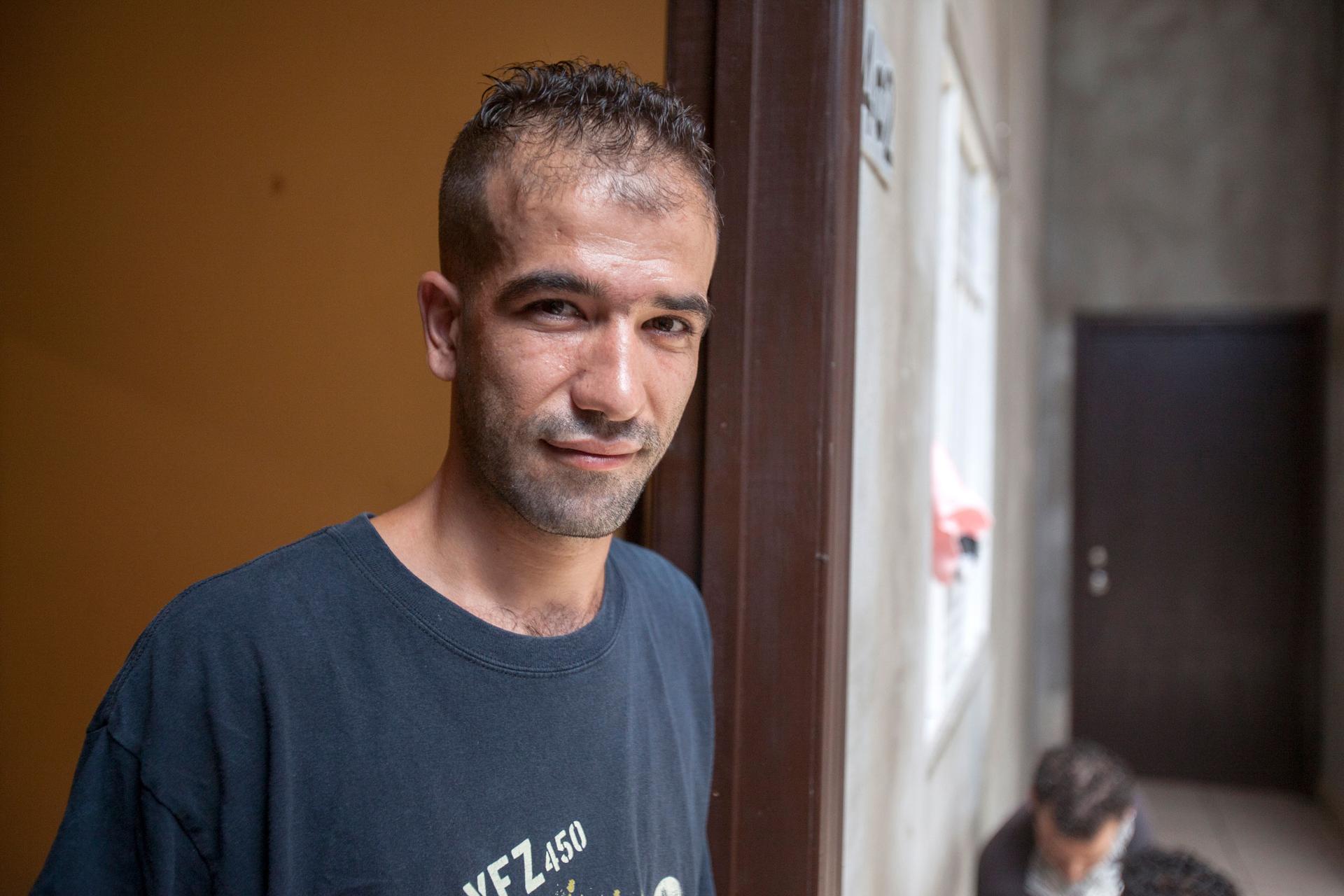
Rawand Rahman, 28, is an Iraqi Kurd who traveled through South America and Central America to reach the US-Mexico border. For a week, he trekked through the Darién Gap, a stretch of rainforest running from Colombia to Panama. It’s a grueling, dangerous and roadless path.
In a video that Rahman took with his phone, which he shared with The World, the jungle is so dense it looks like nighttime under the canopy.
Rahman followed the swampy path dotted with empty water bottles, walking up to six hours each day. This passage was just one leg in Rahman’s three-month journey north. Many migrants like him choose to travel by land because there are tighter visa restrictions for air travel.
Finally, he reached the Mexican border with the US. He’s on day five in Tijuana. He and his brother spent their first two nights on the street here until they got some money wired from home. Now, they share an apartment with six other migrants from Yemen.
Related: Facing US pressure to reduce migration, Mexico cracks down on migrant activists and shelters
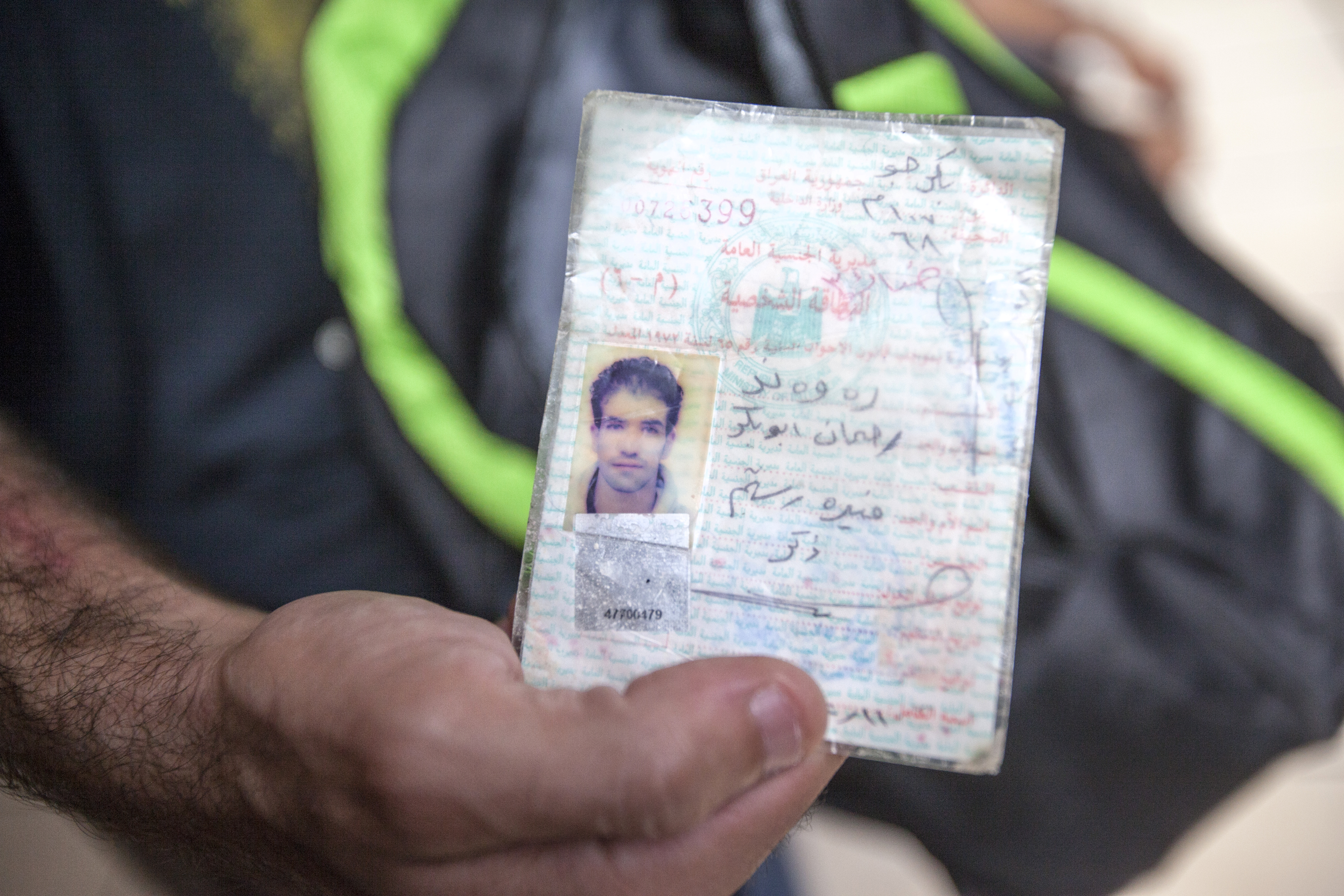
The eight men are squeezed into two small rooms in a rough part of downtown. Altogether, they pay $300 for accommodation each month (or about $40 apiece). There’s one bed that two men share; others use mats rolled up in a corner. A plastic bottle, cut in half, doubles as an ashtray. There is no furniture, just a fan blasting.
Rahman was a welder and a political activist in Iraq, protesting government corruption in the Kurdistan region. He says that led to constant threats and beatings that left him hospitalized. His friends inSão Paulo, Brazil, told him to get a visa and join them. So, he did.
For four years, he lived in Brazil and drove for Uber. Then, his car was stolen, and he was robbed at gunpoint. “So, I lose all that I have. All my life be danger in Iraq, in Brazil, too.”
He says he wants to be somewhere safer. “I say the best place for me is the United States.”
It’s a decision that put him on that path through the jungle and Central America. The hardest part of his trip? Mexico. A police officer in Mexico demanded $500 to let him keep migrating, he says. Rahman pushed back and gave him $200.
Rahman says he headed to Tijuana because someone along the way mentioned you can get across the border faster here. “Some people, they say Tijuana [is] more good, more easy. Faster, the process.”
Related: Migration to US is a family ‘duty’ for many Guatemalans
But the process can be very slow. Just a few blocks from here, there’s a plaza where some migrants put their name on a numbered list to see a US immigration official and petition for asylum.
Rahman says he’ll put his name on the list and wait. He does not want to jump a fence. He also says that he understands why the Trump administration is making it tougher for migrants to enter the United States. He thinks everyone should be vetted before entering the country.
“For me, for myself, I think he’s doing the best way. He’s trying to do the best for the United States. He’s got know who I am. First of all, he’s got to know who I am.”
Juventina
Days in Tijuana, Mexico: 35
Country of origin: Mexico
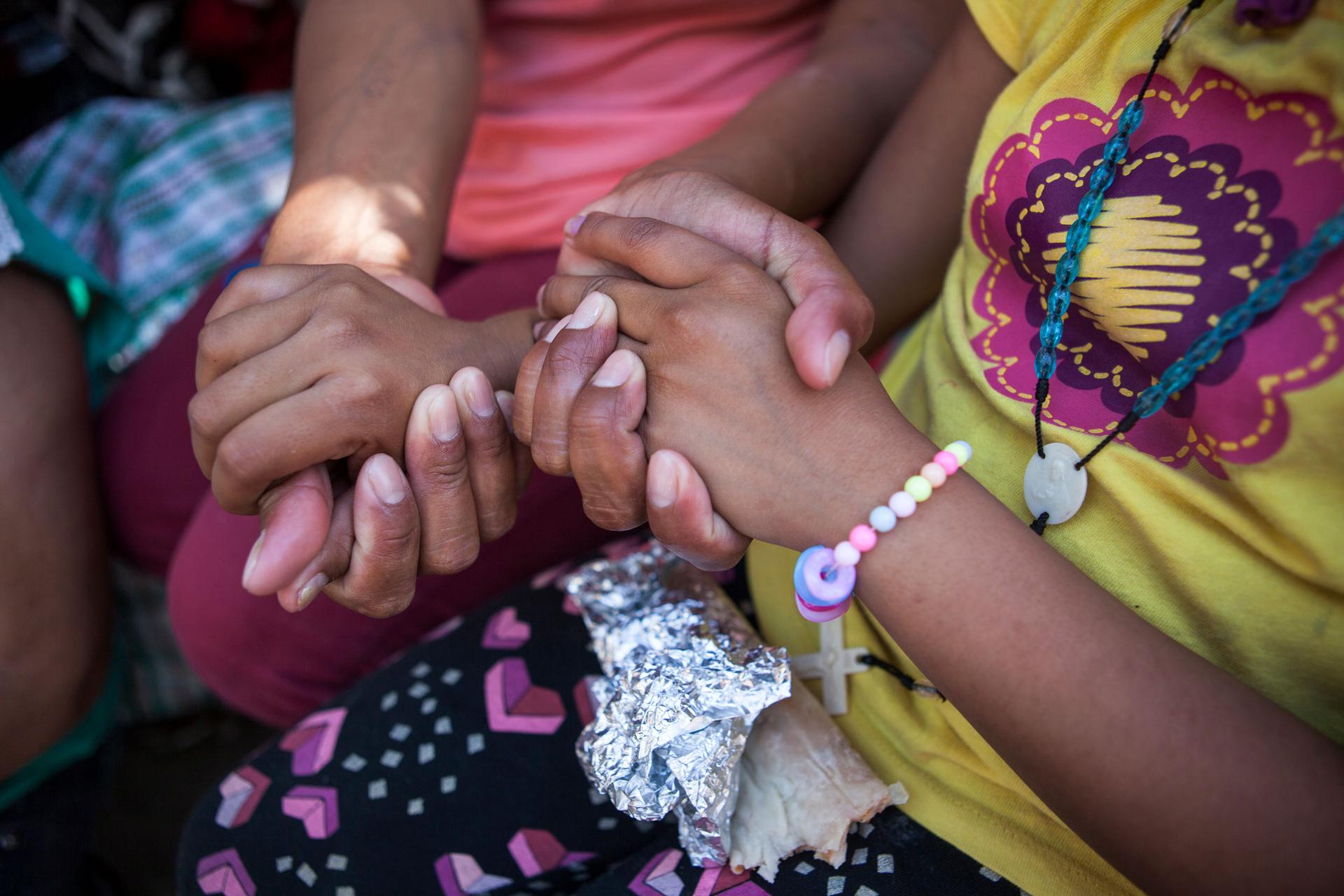
The shelter is packed. People sit wherever they can, on benches, suitcases, fanning themselves in the heat. Kids run around, going a bit stir crazy.
Shelters like this dot Tijuana, and the US-Mexico border. This shelter is for women and children, with people from Haiti, Central America — but also Mexicans fleeing violence.
Related: Mexico’s goodwill wanes as more migrants arrive
Like Juventina, whose full name isn’t being used for her safety. She sits under the shelter’s fig tree watching her two young children. It’s day 35 for them in Tijuana.
Juventina, a lawyer in her 30s, says the trouble began when a powerful cartel took over her town in the Mexican state of Michoacán. She and some of her neighbors spoke out against the cartel’s handpicked candidate for mayor, who lost. Juventina says cartel members blamed her, among others.
Soon after the local election, a text came at 3 a.m. A friend warned: They’re coming for you.
She and her family fled, leaving behind a coconut farm and two small grocery stores. The took what fit into one suitcase: some clothing and documents, including newspaper stories about the cartels, copies of threatening texts, and a police report they filed. Juventina hopes it will help her family make a case for asylum.
But as long as she’s in Mexico — she’s terrified.
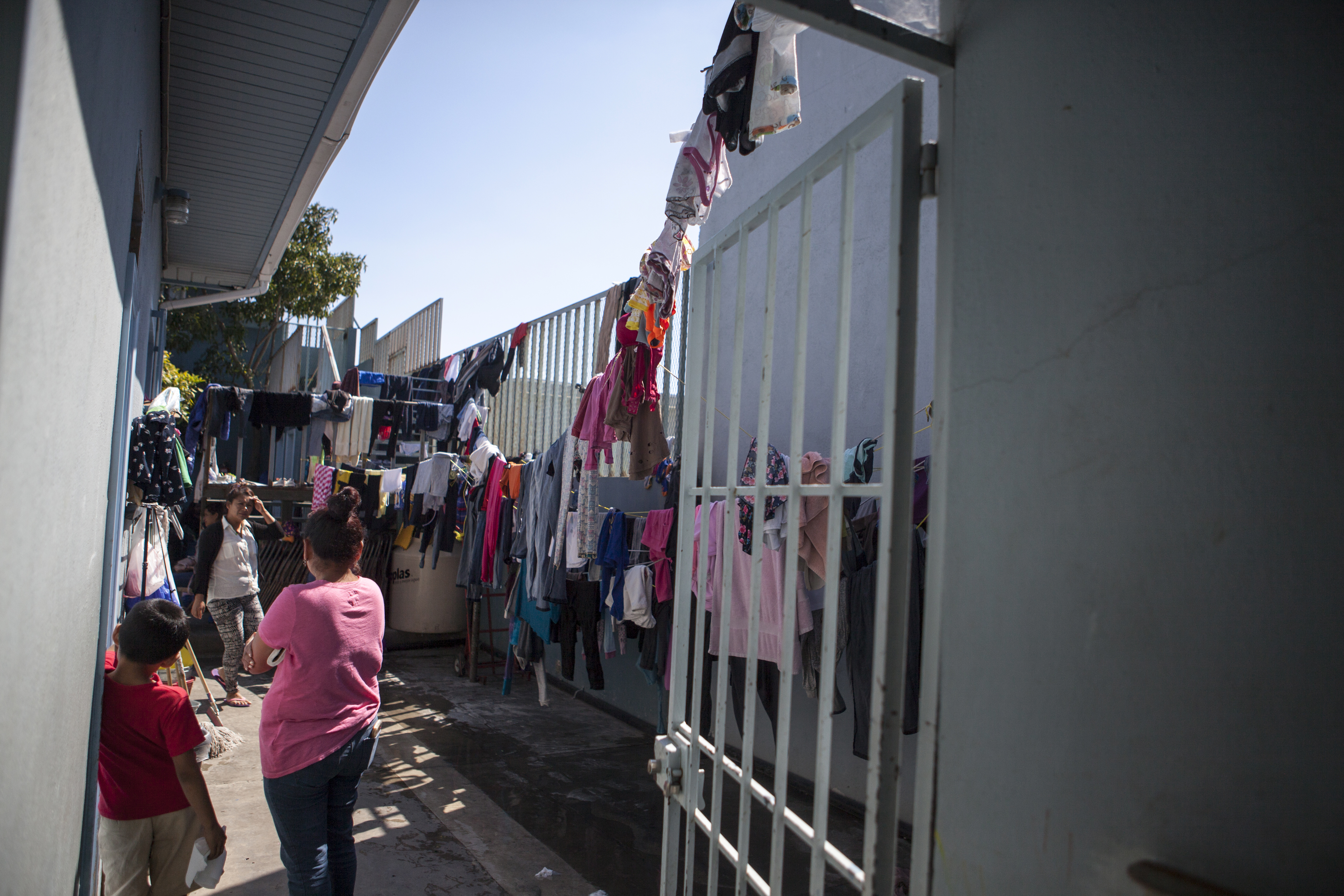
The family only leaves the shelter when they must, she says. (Her husband is nearby at a shelter for men.) She’s worried the cartels will find her family, which is why she asked to use her only her first name. She says she never wanted to leave Mexico.“We’re not here for the ‘American dream,’” she said. “That was never our plan.”
The next day, at a plaza right at the border, migrants gather to hear if their names will be called from a long waitlist. Mexicans should not have to wait on these lists, since they’re already in the country they’re fleeing, but many are stuck on them, anyway.
Related: Crimes of compassion: US follows Europe’s lead in prosecuting those who help migrants
Juventina’s number is 2,749. The number is coming up. While Juventina’s kids wait, they glance at their forearms, marked with their uncle’s telephone number written in black marker. They want to make sure they can call him when they’re in US custody or if they are separated.
When Juventina’s number is finally called, US immigration officials take them into custody. Three days later, Juventina and her family are in San Diego, California. They’ve just been released from a border holding cell — the hielera, or “icebox,” as many migrants call it, because the cells are cold.
Juventina says it was rough. The lights were on nonstop. The kids were afraid.
US officials affixed ankle monitors on Juventina and her husband to track them. They also have an immigration court date soon.
Now, the family is headed for Washington state where they have relatives.
Valery
Days in Tijuana, Mexico: 72
Country of origin: Cameroon
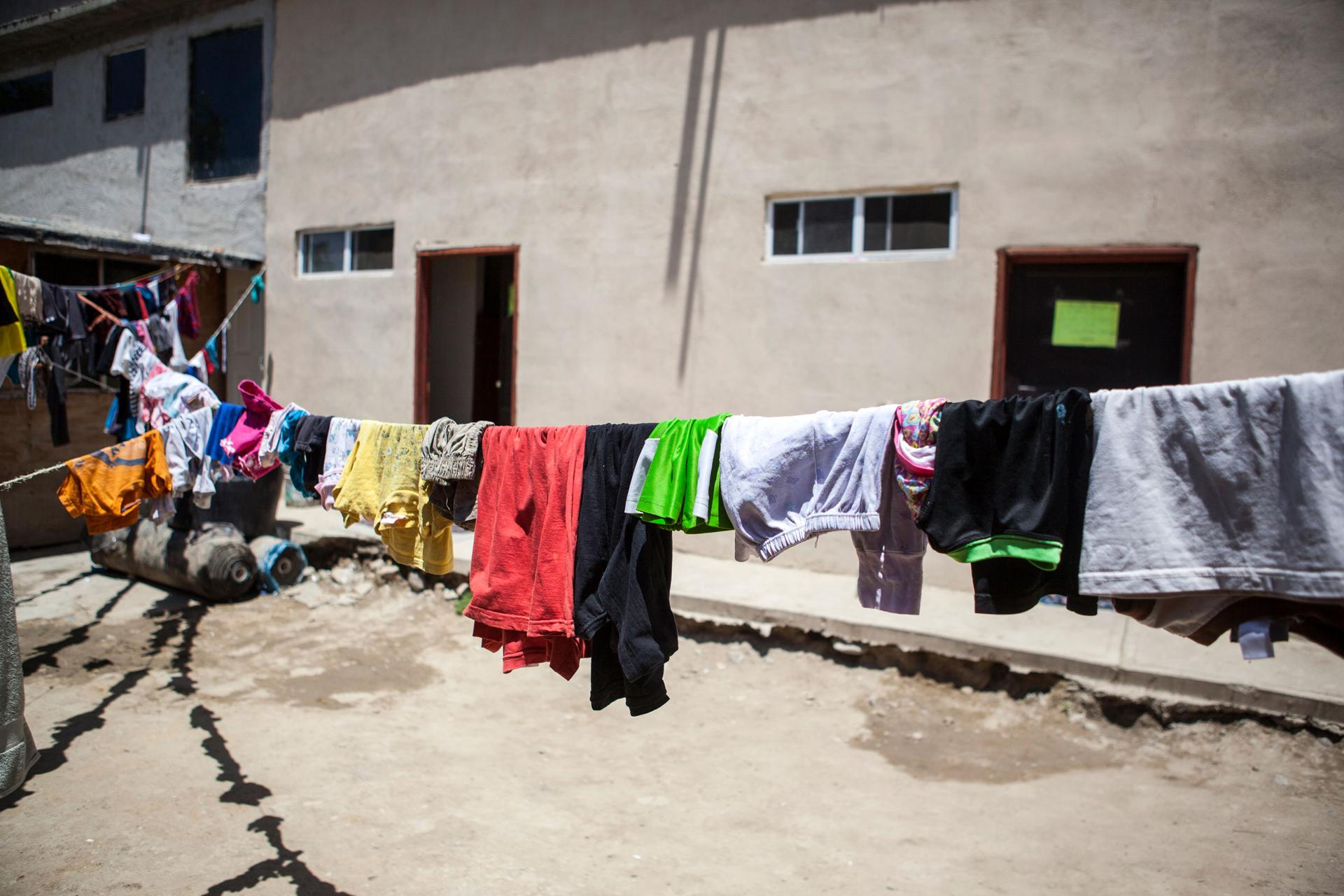
Valery is 7,000 miles from home and going through a hard time. But he’s finishing a meal that makes him feel better.
“I’m always here, because everything I want to eat — I find it here. Like fufu corn and huckleberry and njama njama. Yeah, it’s a vegetable kind of meal. Very, very traditional.”
Related: Why it’s harder to win asylum, even in New York
Stewed huckleberry leaves and rolled corn flour is served in a quiet, tiny restaurant on the ground floor of an apartment building in Tijuana. It’s only blocks from the US border. There’s no sign out front; it’s just known as the African restaurant. When Valery first saw this place, he thought: “Oh, I’m home!”
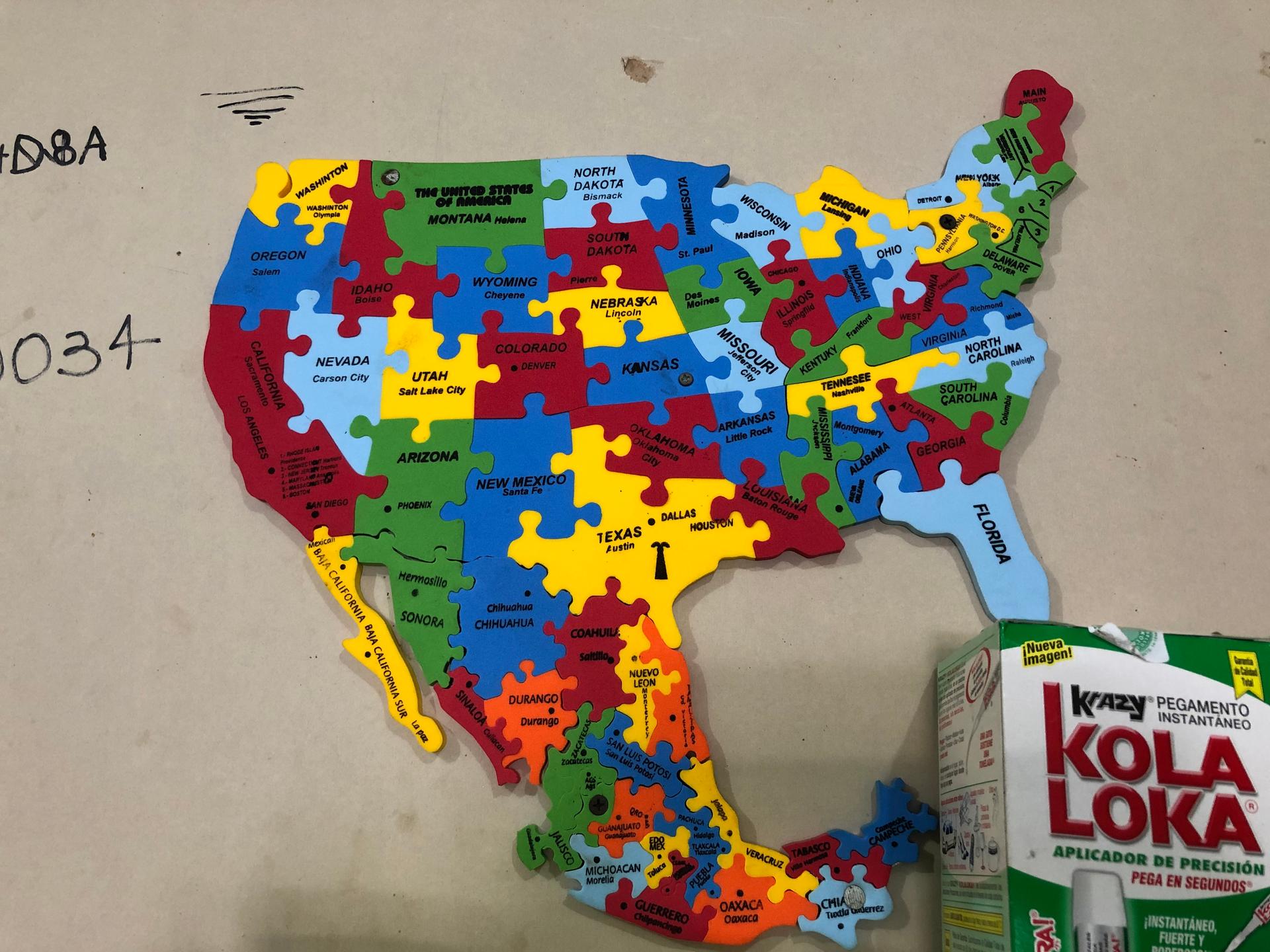
Valery has been in Tijuana 72 days. He says he fled his native Cameroon, which is on the brink of a violent civil war, because groups have been targeting civilians. He had to leave his family behind — and he’s being cautious. He asks to use his first name only.
Over the past year, more people like Valery are heading to Tijuana from Cameroon, Eritrea and Sudan, but also from places like Yemen. He has even run into friends here from his small town in Cameroon, some of whom he thought were dead.
Valery started his trek by flying to Ecuador, a popular gateway to the US because of fewer visa restrictions.
He traveled by land. The worst moment, he says, was being robbed at gunpoint in the jungle in Panama. His attackers took his backpack, passport and cellphone. He says his friend was shot in the leg.
When he got to Tijuana, he didn’t realize there was a long waitlist for asylum-seekers to see a US border official. “I’m surprised! We are begging for a place to stay, as a refugee.”
Valery’s number on the waitlist is 3,500. It might take months to be called.
Meanwhile, he rents a room with others from Cameroon. It’s crammed, so he prefers the restaurant instead. He can spend hours there. He’s in between construction work which, he says, didn’t pay much anyway.
“They were paying me 200, 250 pesos,” he says, about $10 a day. He has some savings and eats just once a day. A plate of food here is about 60 pesos, about $3.
Life is different here than in Cameroon, where he was a trained nurse. Here, he lacks a work permit and does not speak Spanish. He notices that he gets paid less than Central Americans and Mexicans. “You start asking questions. Why is it like that? Is it because I’m black?”
A few days later, he finds another construction job that pays a bit more. It provides some relief, and makes sticking it out here just a bit easier. He is determined to live in the US and points in the direction of the border fence and says: “Oh, God! That’s freedom over there! But I cannot go there.”
Why does he think the Trump administration is blocking more migrants from entering the US?
“I can’t really say. He has his reasons for doing that. Like, I usually say, in every good man, there’s a bad part in him. Likewise, in every bad man, there’s a good part in him. He alone knows why he’s doing all of this.”
Jeff Mendoza
Days in Tijuana, Mexico: 279
Country of origin: Honduras
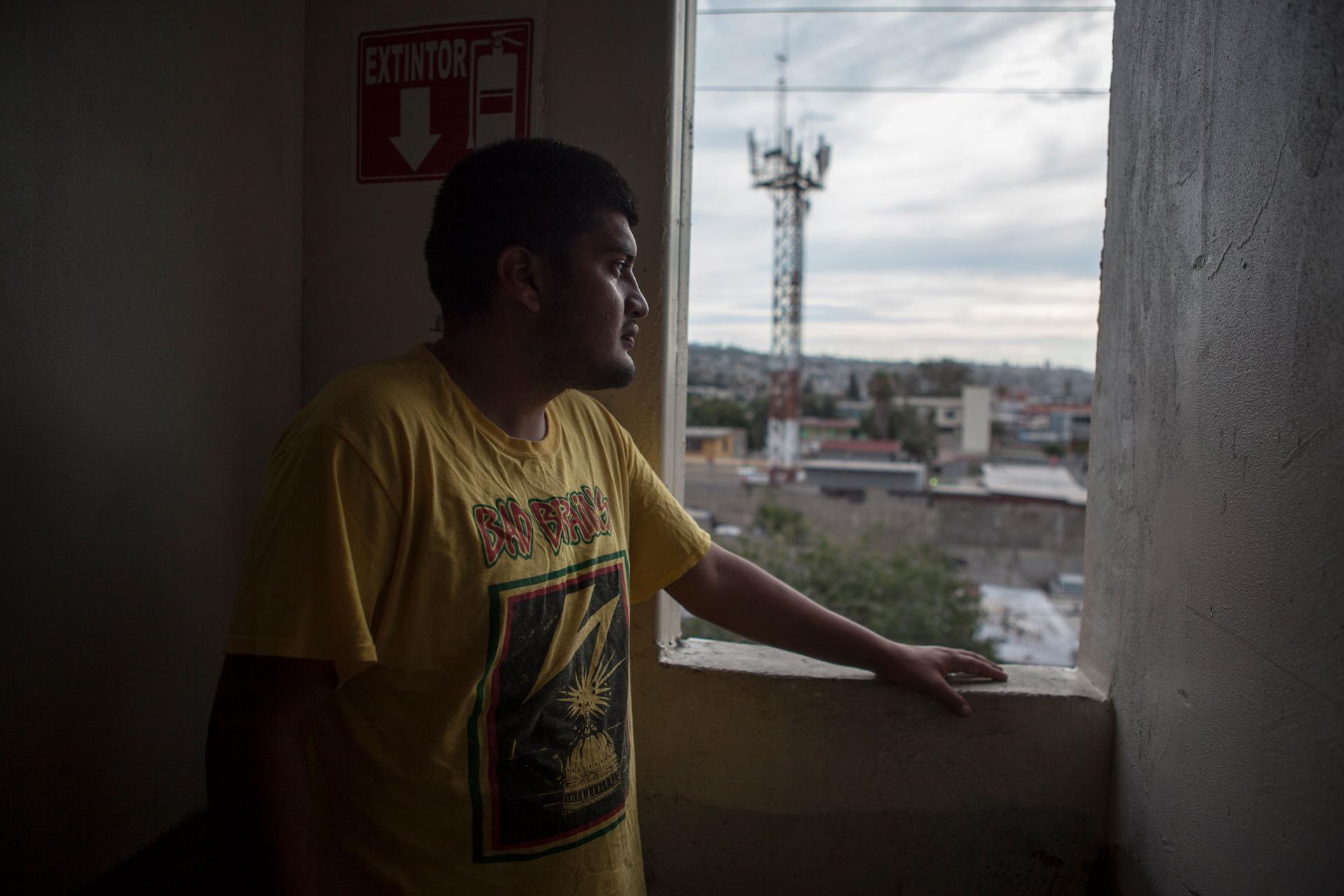
Jeff Mendoza’s apartment is on the third floor of a building where many migrants rent cheap rooms by the week or month.
Back in Honduras, Mendoza, who is 27 years old and wears a black Ramones T-shirt, enjoyed playing bass guitar in a punk rock band. Today, he works a padlock to open the room he is renting in the city’s red-light district. He shares the small space with three other young migrants. There are mattresses on the floor and not much else.
It’s day 279 for Mendoza in Tijuana.
In Honduras, he worked at a store and lived in an area controlled by gangs. Mendoza says that, one afternoon, several police officers stormed into his home, claiming that they were looking for a suspect. They then murdered his dad. Mendoza isn’t clear why that happened — and he and his family demanded answers.
They took their case to human rights groups and that triggered death threats. Mendoza fled Honduras with his sister and her young child.
In Tijuana, his sister and child were allowed into the US and live in Denver now. But Mendoza had to follow a Trump administration policy, launched in late January, that keeps some asylum-seekers in Mexico while their cases proceed in US immigration courts. It’s officially called Migrant Protection Protocols (MPP) (also known informally as “remain in Mexico”).
Related: As judge halts US ‘remain in Mexico’ policy, returned migrants wonder what’s next
With little cash, he, like others in the MPP program, can only afford to live in the city’s high-crime red-light district. He has been violently robbed there several times. His experience is not unusual. Human Rights First, a nonprofit documenting the conditions facing migrants at the US-Mexico border, found more than 110 “publicly reported cases of rape, kidnapping, sexual exploitation, assault, and other violent crimes against asylum seekers returned to Mexico under MPP — likely only the tip of the iceberg, as the vast majority of returned asylum seekers haven’t been interviewed by researchers or journalists.”
The program, which began at the Tijuana border crossing, has since expanded east, returning migrants to Mexicali, Ciudad Juárez and, most recently, to Nuevo Laredo, in the state of Tamaulipas. The state carries US State Department travel warning because of kidnappings and other crimes.
Mendoza says his experience with the Migrant Protection Protocols program has been disastrous. When he was escorted to his first court hearing, in San Diego, US officials took away his backpack and never gave it back. The bag contained his passport, documentation for his asylum case, a phone and cash.
Then, Mendoza was scheduled for a second court hearing this summer. But when the date was moved, Mendoza says that he was not notified (he does not have a mailbox). This has happened to others in MPP as well. Some US officials have called the scheduling changes “glitches.”
Mendoza worries that glitch torpedoed his chance at asylum. As of now, his case has been terminated, and it’s unclear whether he can reopen it. Immigration officials didn’t respond to The World’s questions about Mendoza’s case.
Mendoza says he will try and push his case forward on his own, but he is feeling worn down. And he thinks that is precisely the program’s aim — to wear migrants down and convince them to return home.
Mendoza says that some days he feels just as unsafe here as in Honduras.
He lives in a high-crime part of town, and shows two fresh scars on his forearm — knife wounds from when a group of men stole his phone. He says he has been robbed here several times, including by the police. Numerous migrants waiting out their court cases in Mexico have reported kidnappings and other assaults.
In the meantime, he works six days a week at a construction site to afford food and rent, about $15 each a week here.
To escape, he listens to music. Along with the Ramones, his other favorite band is Bad Brains. He also enjoys the protest songs against the president of Honduras, Juan Orlando Hernández. Just this week, calls for the president’s resignation are intensifying based on allegations that he financed his campaign with cash from organized criminal groups.
Mendoza says he is afraid to go back to Honduras, but he misses his relatives and bandmates. That life feels far away now, and he’s not sure where his new one will be.
